Taxation Law: Deductions, GST, and Legal Expenses Analysis
VerifiedAdded on 2020/04/07
|17
|2660
|32
Homework Assignment
AI Summary
This taxation law assignment comprehensively addresses several key issues in Australian tax law. The first question delves into the allowability of deductions under Section 8-1 of the ITAA 1997, analyzing scenarios involving machinery relocation, asset revaluation due to insurance, and legal expenses related to business operations, including winding-up petitions. The analysis incorporates relevant case law, such as British Insulated & Helsby Cables and FC of T v Snowden and Wilson Pty Ltd, and taxation rulings to determine whether specific costs constitute capital expenditure or allowable business expenses. The second question focuses on input tax credits under the GST Act 1999, specifically concerning advertising expenditure. It examines the application of Goods and Service Taxation Ruling of GSTR 2006/3 and case law like Ronpibon Tin NL v FC of T to ascertain the eligibility of input tax credits for a company's advertising expenses, considering the creditable purpose and financial supply thresholds. The assignment provides a detailed legal analysis of each scenario, concluding whether the expenses are deductible or subject to GST implications based on the applicable legislation and rulings.
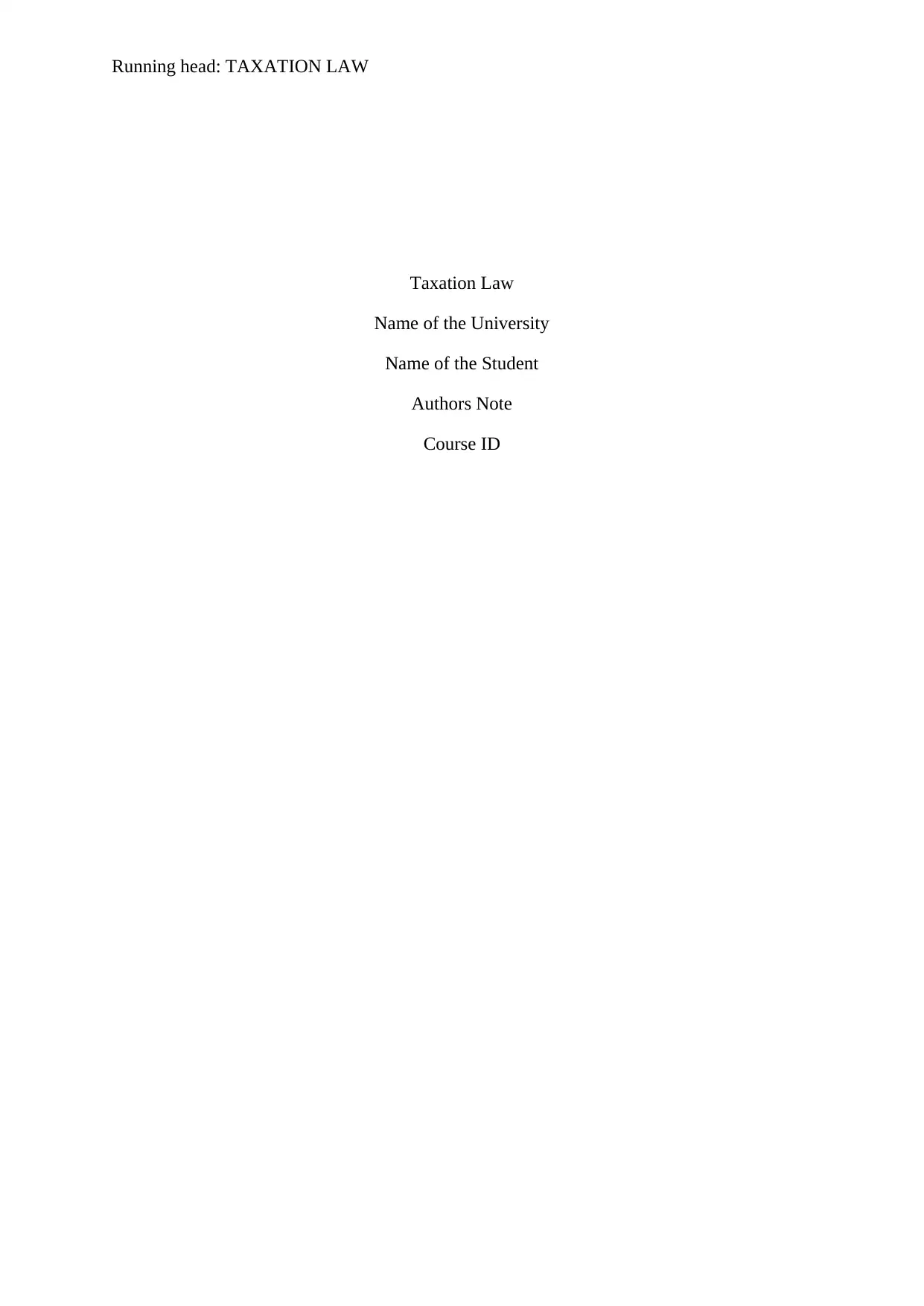
Running head: TAXATION LAW
Taxation Law
Name of the University
Name of the Student
Authors Note
Course ID
Taxation Law
Name of the University
Name of the Student
Authors Note
Course ID
Paraphrase This Document
Need a fresh take? Get an instant paraphrase of this document with our AI Paraphraser
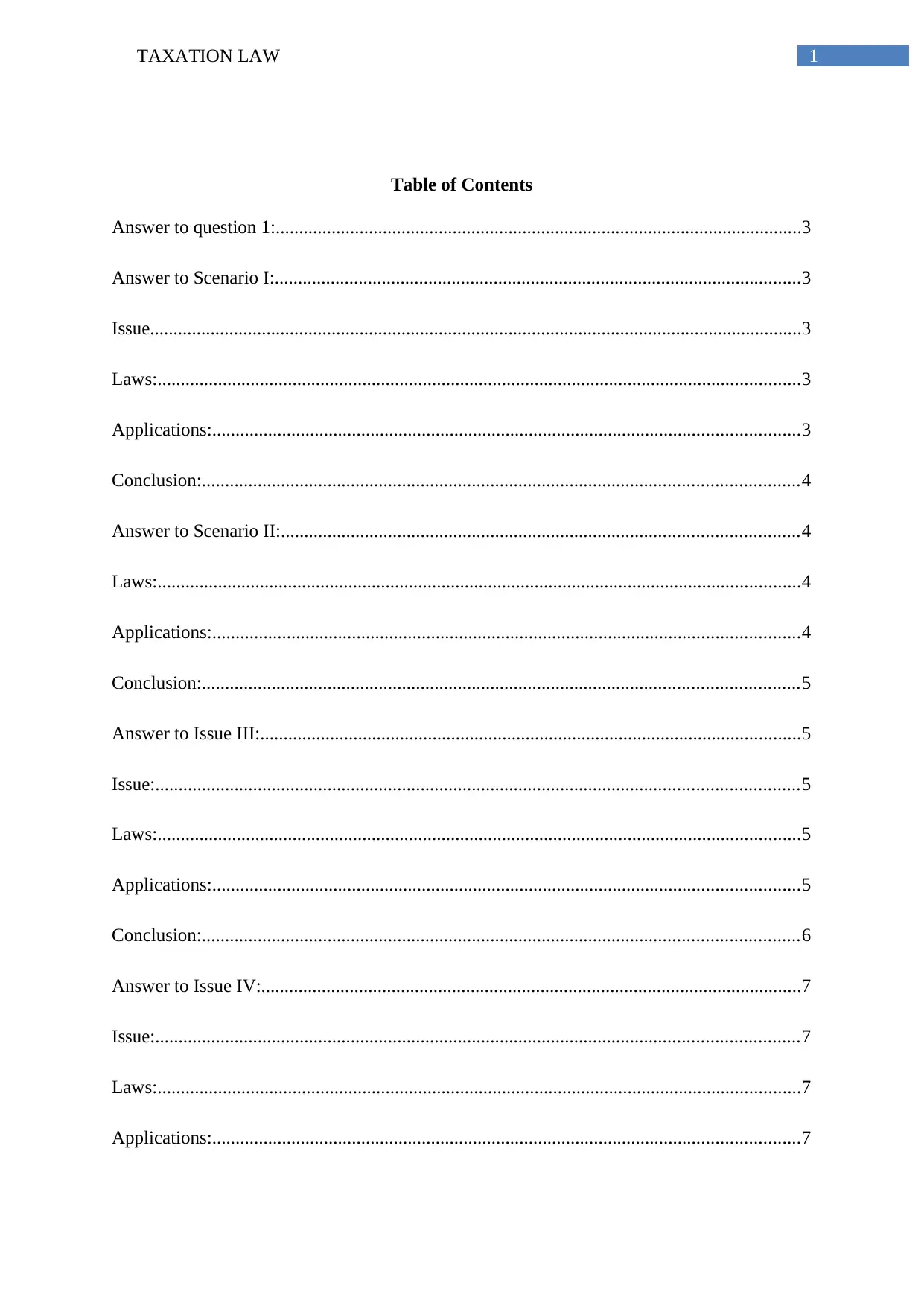
1TAXATION LAW
Table of Contents
Answer to question 1:.................................................................................................................3
Answer to Scenario I:.................................................................................................................3
Issue............................................................................................................................................3
Laws:..........................................................................................................................................3
Applications:..............................................................................................................................3
Conclusion:................................................................................................................................4
Answer to Scenario II:...............................................................................................................4
Laws:..........................................................................................................................................4
Applications:..............................................................................................................................4
Conclusion:................................................................................................................................5
Answer to Issue III:....................................................................................................................5
Issue:..........................................................................................................................................5
Laws:..........................................................................................................................................5
Applications:..............................................................................................................................5
Conclusion:................................................................................................................................6
Answer to Issue IV:....................................................................................................................7
Issue:..........................................................................................................................................7
Laws:..........................................................................................................................................7
Applications:..............................................................................................................................7
Table of Contents
Answer to question 1:.................................................................................................................3
Answer to Scenario I:.................................................................................................................3
Issue............................................................................................................................................3
Laws:..........................................................................................................................................3
Applications:..............................................................................................................................3
Conclusion:................................................................................................................................4
Answer to Scenario II:...............................................................................................................4
Laws:..........................................................................................................................................4
Applications:..............................................................................................................................4
Conclusion:................................................................................................................................5
Answer to Issue III:....................................................................................................................5
Issue:..........................................................................................................................................5
Laws:..........................................................................................................................................5
Applications:..............................................................................................................................5
Conclusion:................................................................................................................................6
Answer to Issue IV:....................................................................................................................7
Issue:..........................................................................................................................................7
Laws:..........................................................................................................................................7
Applications:..............................................................................................................................7
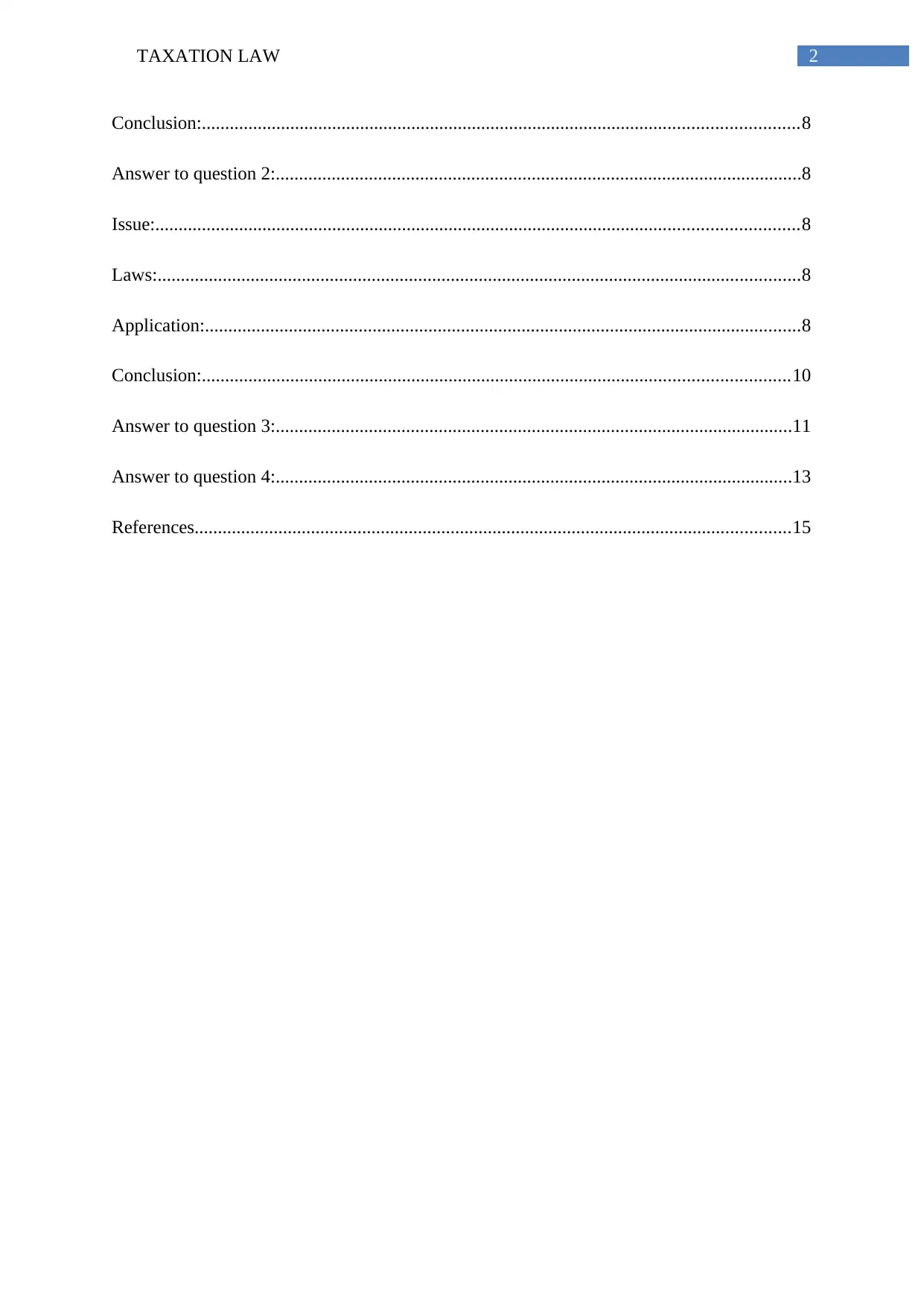
2TAXATION LAW
Conclusion:................................................................................................................................8
Answer to question 2:.................................................................................................................8
Issue:..........................................................................................................................................8
Laws:..........................................................................................................................................8
Application:................................................................................................................................8
Conclusion:..............................................................................................................................10
Answer to question 3:...............................................................................................................11
Answer to question 4:...............................................................................................................13
References................................................................................................................................15
Conclusion:................................................................................................................................8
Answer to question 2:.................................................................................................................8
Issue:..........................................................................................................................................8
Laws:..........................................................................................................................................8
Application:................................................................................................................................8
Conclusion:..............................................................................................................................10
Answer to question 3:...............................................................................................................11
Answer to question 4:...............................................................................................................13
References................................................................................................................................15
⊘ This is a preview!⊘
Do you want full access?
Subscribe today to unlock all pages.

Trusted by 1+ million students worldwide
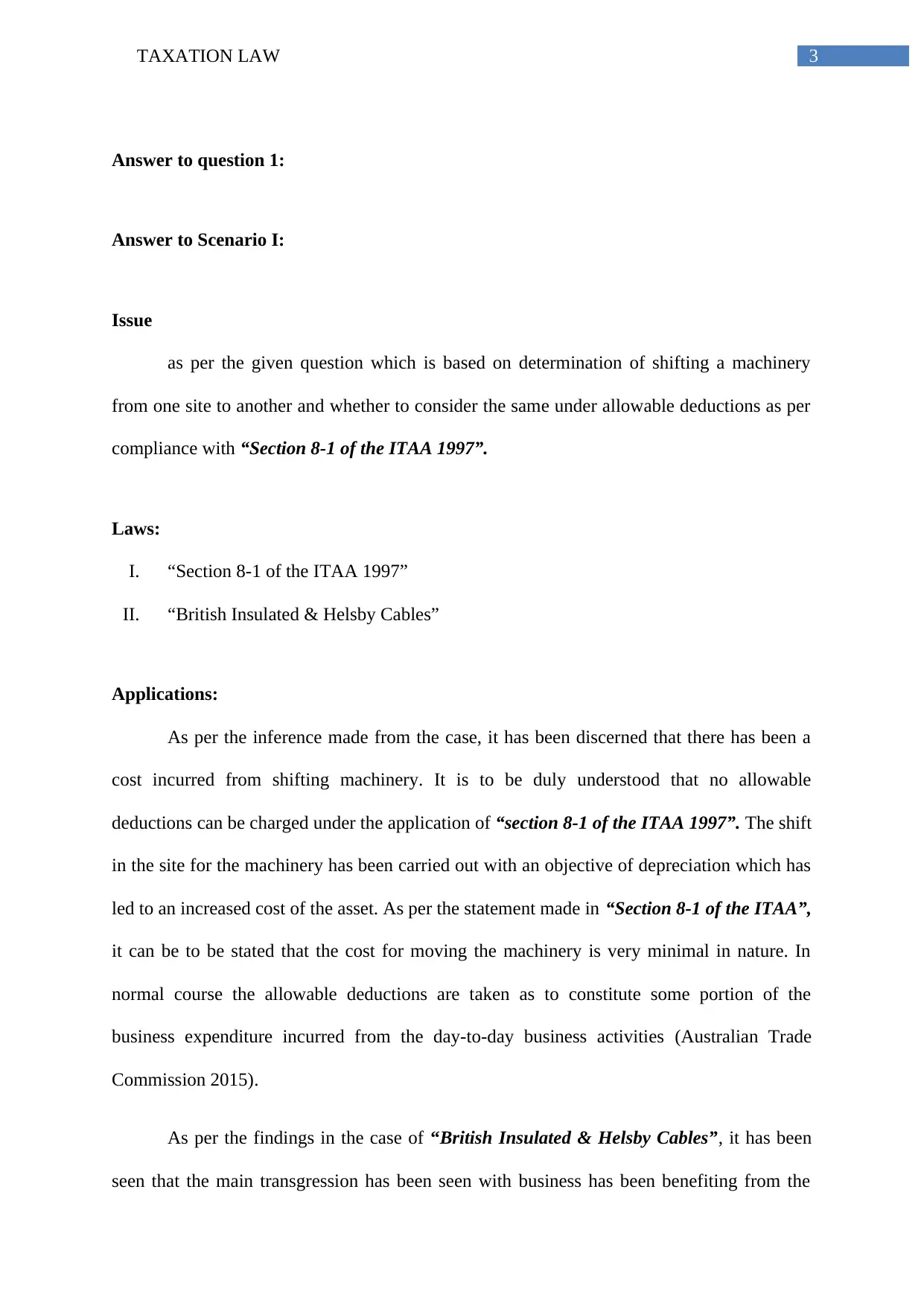
3TAXATION LAW
Answer to question 1:
Answer to Scenario I:
Issue
as per the given question which is based on determination of shifting a machinery
from one site to another and whether to consider the same under allowable deductions as per
compliance with “Section 8-1 of the ITAA 1997”.
Laws:
I. “Section 8-1 of the ITAA 1997”
II. “British Insulated & Helsby Cables”
Applications:
As per the inference made from the case, it has been discerned that there has been a
cost incurred from shifting machinery. It is to be duly understood that no allowable
deductions can be charged under the application of “section 8-1 of the ITAA 1997”. The shift
in the site for the machinery has been carried out with an objective of depreciation which has
led to an increased cost of the asset. As per the statement made in “Section 8-1 of the ITAA”,
it can be to be stated that the cost for moving the machinery is very minimal in nature. In
normal course the allowable deductions are taken as to constitute some portion of the
business expenditure incurred from the day-to-day business activities (Australian Trade
Commission 2015).
As per the findings in the case of “British Insulated & Helsby Cables”, it has been
seen that the main transgression has been seen with business has been benefiting from the
Answer to question 1:
Answer to Scenario I:
Issue
as per the given question which is based on determination of shifting a machinery
from one site to another and whether to consider the same under allowable deductions as per
compliance with “Section 8-1 of the ITAA 1997”.
Laws:
I. “Section 8-1 of the ITAA 1997”
II. “British Insulated & Helsby Cables”
Applications:
As per the inference made from the case, it has been discerned that there has been a
cost incurred from shifting machinery. It is to be duly understood that no allowable
deductions can be charged under the application of “section 8-1 of the ITAA 1997”. The shift
in the site for the machinery has been carried out with an objective of depreciation which has
led to an increased cost of the asset. As per the statement made in “Section 8-1 of the ITAA”,
it can be to be stated that the cost for moving the machinery is very minimal in nature. In
normal course the allowable deductions are taken as to constitute some portion of the
business expenditure incurred from the day-to-day business activities (Australian Trade
Commission 2015).
As per the findings in the case of “British Insulated & Helsby Cables”, it has been
seen that the main transgression has been seen with business has been benefiting from the
Paraphrase This Document
Need a fresh take? Get an instant paraphrase of this document with our AI Paraphraser
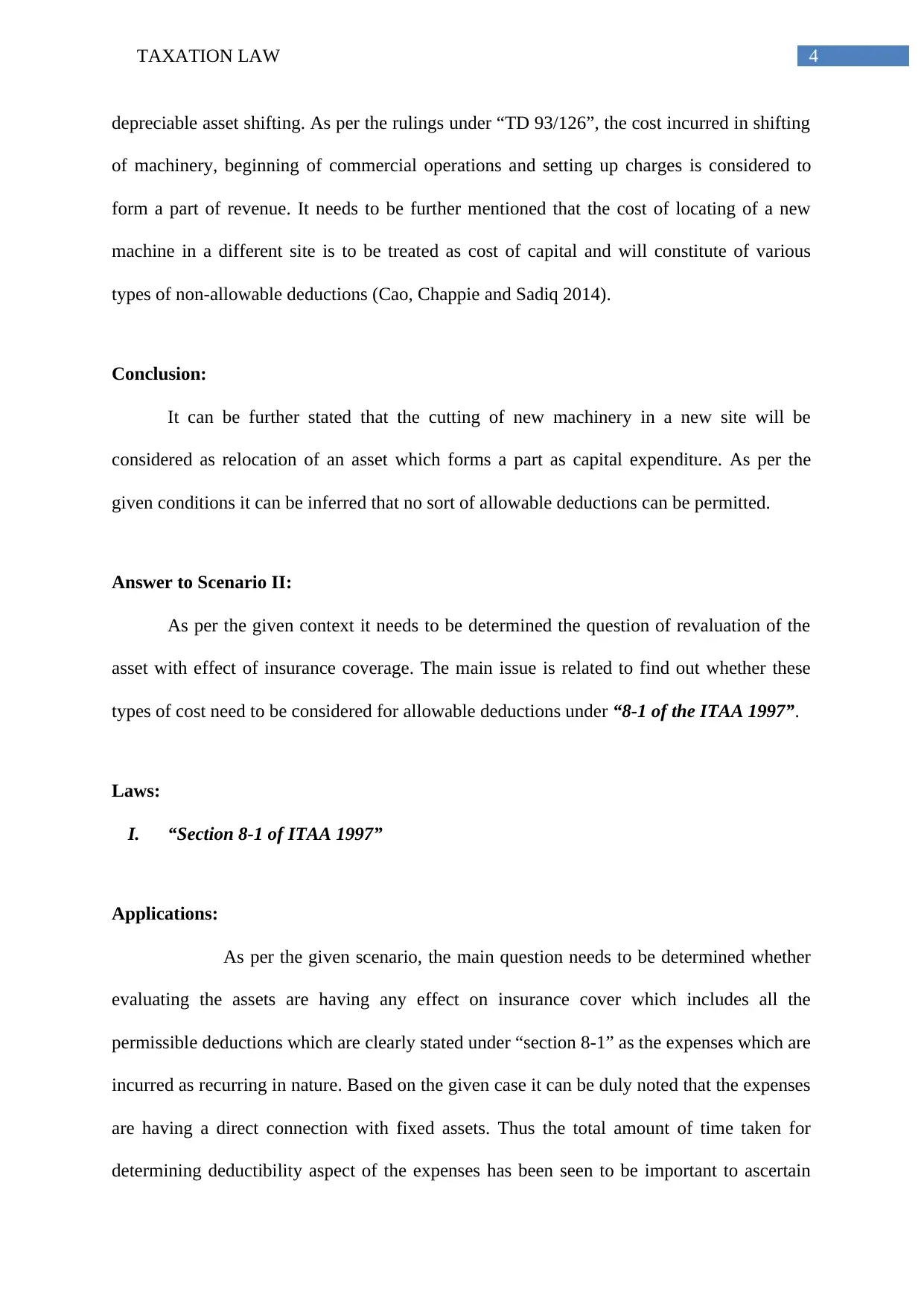
4TAXATION LAW
depreciable asset shifting. As per the rulings under “TD 93/126”, the cost incurred in shifting
of machinery, beginning of commercial operations and setting up charges is considered to
form a part of revenue. It needs to be further mentioned that the cost of locating of a new
machine in a different site is to be treated as cost of capital and will constitute of various
types of non-allowable deductions (Cao, Chappie and Sadiq 2014).
Conclusion:
It can be further stated that the cutting of new machinery in a new site will be
considered as relocation of an asset which forms a part as capital expenditure. As per the
given conditions it can be inferred that no sort of allowable deductions can be permitted.
Answer to Scenario II:
As per the given context it needs to be determined the question of revaluation of the
asset with effect of insurance coverage. The main issue is related to find out whether these
types of cost need to be considered for allowable deductions under “8-1 of the ITAA 1997”.
Laws:
I. “Section 8-1 of ITAA 1997”
Applications:
As per the given scenario, the main question needs to be determined whether
evaluating the assets are having any effect on insurance cover which includes all the
permissible deductions which are clearly stated under “section 8-1” as the expenses which are
incurred as recurring in nature. Based on the given case it can be duly noted that the expenses
are having a direct connection with fixed assets. Thus the total amount of time taken for
determining deductibility aspect of the expenses has been seen to be important to ascertain
depreciable asset shifting. As per the rulings under “TD 93/126”, the cost incurred in shifting
of machinery, beginning of commercial operations and setting up charges is considered to
form a part of revenue. It needs to be further mentioned that the cost of locating of a new
machine in a different site is to be treated as cost of capital and will constitute of various
types of non-allowable deductions (Cao, Chappie and Sadiq 2014).
Conclusion:
It can be further stated that the cutting of new machinery in a new site will be
considered as relocation of an asset which forms a part as capital expenditure. As per the
given conditions it can be inferred that no sort of allowable deductions can be permitted.
Answer to Scenario II:
As per the given context it needs to be determined the question of revaluation of the
asset with effect of insurance coverage. The main issue is related to find out whether these
types of cost need to be considered for allowable deductions under “8-1 of the ITAA 1997”.
Laws:
I. “Section 8-1 of ITAA 1997”
Applications:
As per the given scenario, the main question needs to be determined whether
evaluating the assets are having any effect on insurance cover which includes all the
permissible deductions which are clearly stated under “section 8-1” as the expenses which are
incurred as recurring in nature. Based on the given case it can be duly noted that the expenses
are having a direct connection with fixed assets. Thus the total amount of time taken for
determining deductibility aspect of the expenses has been seen to be important to ascertain
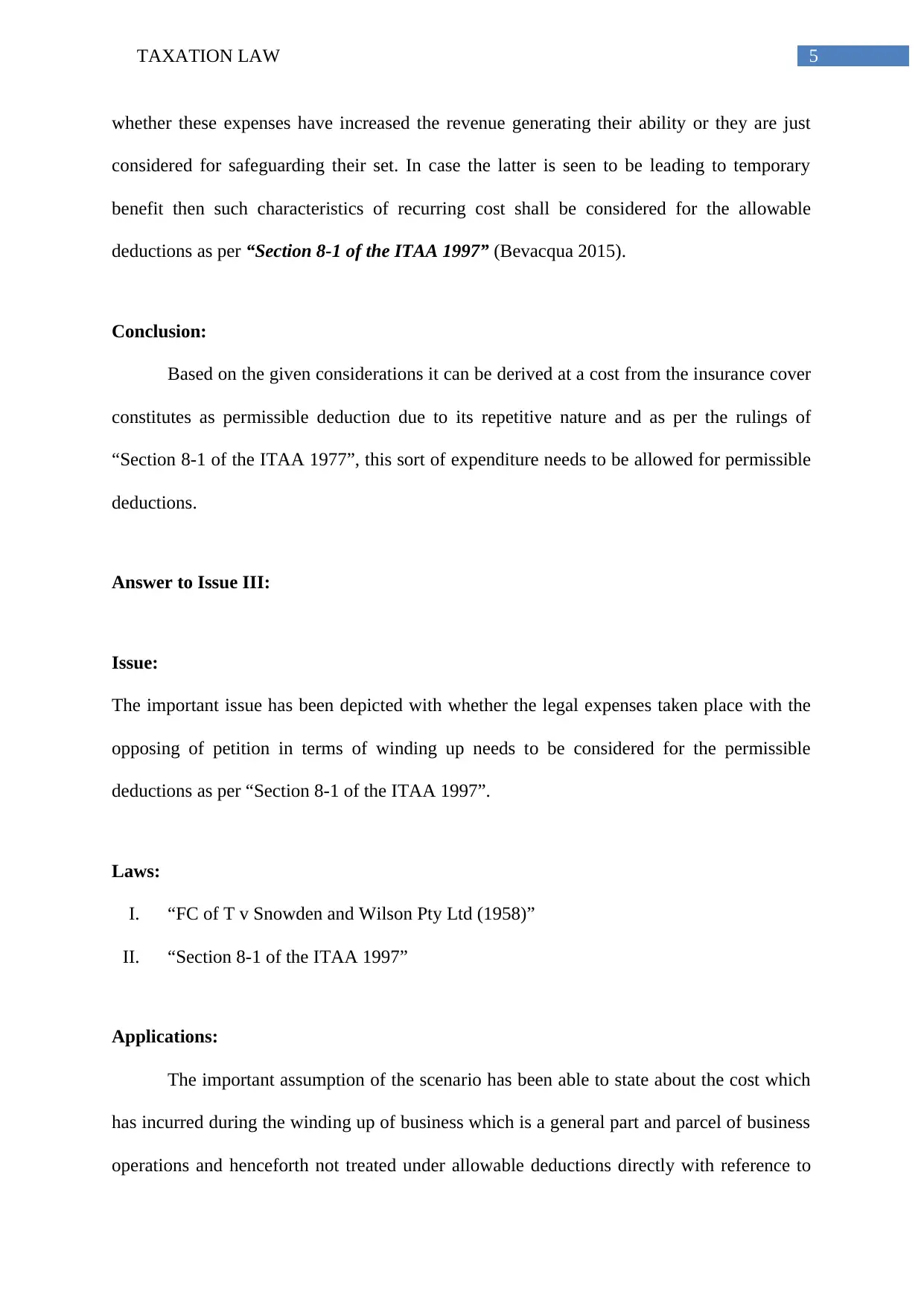
5TAXATION LAW
whether these expenses have increased the revenue generating their ability or they are just
considered for safeguarding their set. In case the latter is seen to be leading to temporary
benefit then such characteristics of recurring cost shall be considered for the allowable
deductions as per “Section 8-1 of the ITAA 1997” (Bevacqua 2015).
Conclusion:
Based on the given considerations it can be derived at a cost from the insurance cover
constitutes as permissible deduction due to its repetitive nature and as per the rulings of
“Section 8-1 of the ITAA 1977”, this sort of expenditure needs to be allowed for permissible
deductions.
Answer to Issue III:
Issue:
The important issue has been depicted with whether the legal expenses taken place with the
opposing of petition in terms of winding up needs to be considered for the permissible
deductions as per “Section 8-1 of the ITAA 1997”.
Laws:
I. “FC of T v Snowden and Wilson Pty Ltd (1958)”
II. “Section 8-1 of the ITAA 1997”
Applications:
The important assumption of the scenario has been able to state about the cost which
has incurred during the winding up of business which is a general part and parcel of business
operations and henceforth not treated under allowable deductions directly with reference to
whether these expenses have increased the revenue generating their ability or they are just
considered for safeguarding their set. In case the latter is seen to be leading to temporary
benefit then such characteristics of recurring cost shall be considered for the allowable
deductions as per “Section 8-1 of the ITAA 1997” (Bevacqua 2015).
Conclusion:
Based on the given considerations it can be derived at a cost from the insurance cover
constitutes as permissible deduction due to its repetitive nature and as per the rulings of
“Section 8-1 of the ITAA 1977”, this sort of expenditure needs to be allowed for permissible
deductions.
Answer to Issue III:
Issue:
The important issue has been depicted with whether the legal expenses taken place with the
opposing of petition in terms of winding up needs to be considered for the permissible
deductions as per “Section 8-1 of the ITAA 1997”.
Laws:
I. “FC of T v Snowden and Wilson Pty Ltd (1958)”
II. “Section 8-1 of the ITAA 1997”
Applications:
The important assumption of the scenario has been able to state about the cost which
has incurred during the winding up of business which is a general part and parcel of business
operations and henceforth not treated under allowable deductions directly with reference to
⊘ This is a preview!⊘
Do you want full access?
Subscribe today to unlock all pages.

Trusted by 1+ million students worldwide
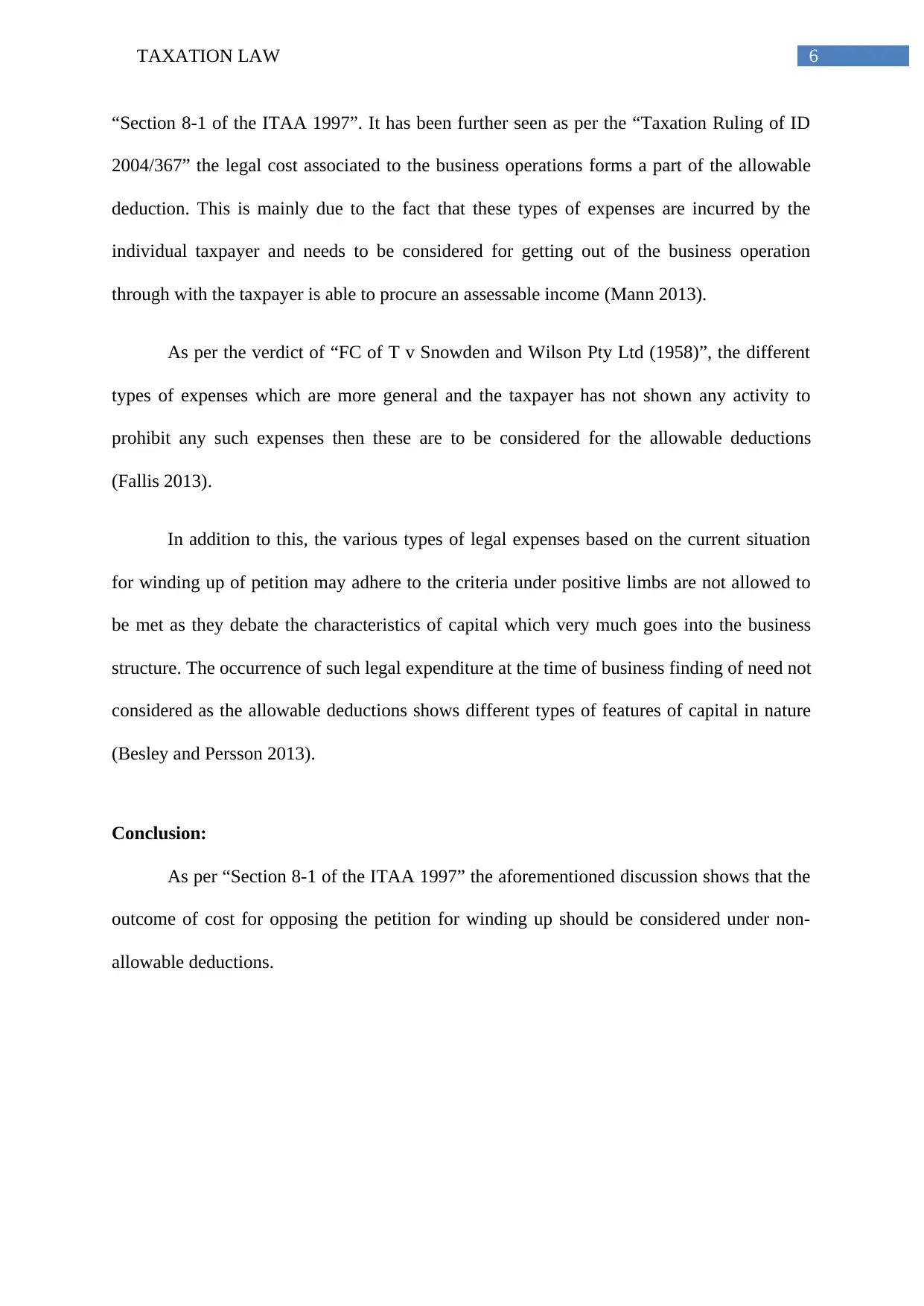
6TAXATION LAW
“Section 8-1 of the ITAA 1997”. It has been further seen as per the “Taxation Ruling of ID
2004/367” the legal cost associated to the business operations forms a part of the allowable
deduction. This is mainly due to the fact that these types of expenses are incurred by the
individual taxpayer and needs to be considered for getting out of the business operation
through with the taxpayer is able to procure an assessable income (Mann 2013).
As per the verdict of “FC of T v Snowden and Wilson Pty Ltd (1958)”, the different
types of expenses which are more general and the taxpayer has not shown any activity to
prohibit any such expenses then these are to be considered for the allowable deductions
(Fallis 2013).
In addition to this, the various types of legal expenses based on the current situation
for winding up of petition may adhere to the criteria under positive limbs are not allowed to
be met as they debate the characteristics of capital which very much goes into the business
structure. The occurrence of such legal expenditure at the time of business finding of need not
considered as the allowable deductions shows different types of features of capital in nature
(Besley and Persson 2013).
Conclusion:
As per “Section 8-1 of the ITAA 1997” the aforementioned discussion shows that the
outcome of cost for opposing the petition for winding up should be considered under non-
allowable deductions.
“Section 8-1 of the ITAA 1997”. It has been further seen as per the “Taxation Ruling of ID
2004/367” the legal cost associated to the business operations forms a part of the allowable
deduction. This is mainly due to the fact that these types of expenses are incurred by the
individual taxpayer and needs to be considered for getting out of the business operation
through with the taxpayer is able to procure an assessable income (Mann 2013).
As per the verdict of “FC of T v Snowden and Wilson Pty Ltd (1958)”, the different
types of expenses which are more general and the taxpayer has not shown any activity to
prohibit any such expenses then these are to be considered for the allowable deductions
(Fallis 2013).
In addition to this, the various types of legal expenses based on the current situation
for winding up of petition may adhere to the criteria under positive limbs are not allowed to
be met as they debate the characteristics of capital which very much goes into the business
structure. The occurrence of such legal expenditure at the time of business finding of need not
considered as the allowable deductions shows different types of features of capital in nature
(Besley and Persson 2013).
Conclusion:
As per “Section 8-1 of the ITAA 1997” the aforementioned discussion shows that the
outcome of cost for opposing the petition for winding up should be considered under non-
allowable deductions.
Paraphrase This Document
Need a fresh take? Get an instant paraphrase of this document with our AI Paraphraser

7TAXATION LAW
Answer to Issue IV:
Issue:
The main issue has been able to discuss on whether the legal expenses borne
by the taxpayer by the service of the Solicitor constitute the deductions as per the rulings of
“section 8-1 of the ITAA 1997”.
Laws:
I. “Section 8-1 of the ITAA 1997”
Applications:
The application of the aforementioned legislation has been able to put forward the
question whether the taxpayer has incurred the legal cost in terms of business operation
which needs to be accountable for permissible deductions as per “section 8-1 of the ITAA
1997”. However, there are certain exceptions associated legal expenditure through which the
taxpayer takes a service from the Solicitor. In case the expenses are depicted with capital
characteristics, Private or domestic then these cannot be considered as allowable deductions
(Australian Government 2015).
As per the given explanation, the legal expenditure of the taxpayer has not
been able to form a part of the business income as it is not associated to process of carrying
the business activities and henceforth it cannot be considered under allowable deductions. It
can be further discerned that the legal expenditure of the taxpayer in the present situation
needs to be considered for the allowable deductions. The main consideration of allowing that
deduction is due to the fact that expenditure resembles characteristics of business operations
Answer to Issue IV:
Issue:
The main issue has been able to discuss on whether the legal expenses borne
by the taxpayer by the service of the Solicitor constitute the deductions as per the rulings of
“section 8-1 of the ITAA 1997”.
Laws:
I. “Section 8-1 of the ITAA 1997”
Applications:
The application of the aforementioned legislation has been able to put forward the
question whether the taxpayer has incurred the legal cost in terms of business operation
which needs to be accountable for permissible deductions as per “section 8-1 of the ITAA
1997”. However, there are certain exceptions associated legal expenditure through which the
taxpayer takes a service from the Solicitor. In case the expenses are depicted with capital
characteristics, Private or domestic then these cannot be considered as allowable deductions
(Australian Government 2015).
As per the given explanation, the legal expenditure of the taxpayer has not
been able to form a part of the business income as it is not associated to process of carrying
the business activities and henceforth it cannot be considered under allowable deductions. It
can be further discerned that the legal expenditure of the taxpayer in the present situation
needs to be considered for the allowable deductions. The main consideration of allowing that
deduction is due to the fact that expenditure resembles characteristics of business operations
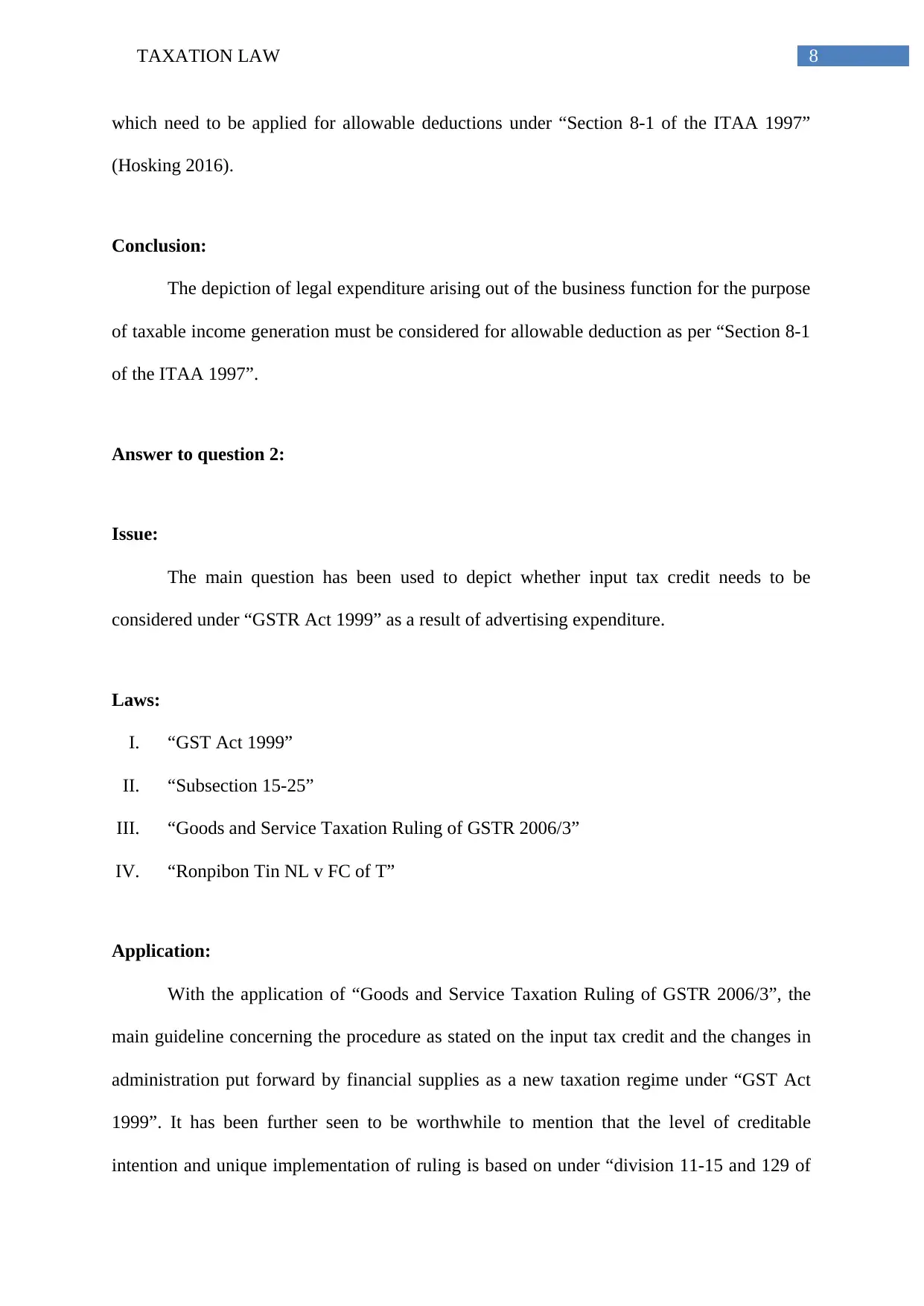
8TAXATION LAW
which need to be applied for allowable deductions under “Section 8-1 of the ITAA 1997”
(Hosking 2016).
Conclusion:
The depiction of legal expenditure arising out of the business function for the purpose
of taxable income generation must be considered for allowable deduction as per “Section 8-1
of the ITAA 1997”.
Answer to question 2:
Issue:
The main question has been used to depict whether input tax credit needs to be
considered under “GSTR Act 1999” as a result of advertising expenditure.
Laws:
I. “GST Act 1999”
II. “Subsection 15-25”
III. “Goods and Service Taxation Ruling of GSTR 2006/3”
IV. “Ronpibon Tin NL v FC of T”
Application:
With the application of “Goods and Service Taxation Ruling of GSTR 2006/3”, the
main guideline concerning the procedure as stated on the input tax credit and the changes in
administration put forward by financial supplies as a new taxation regime under “GST Act
1999”. It has been further seen to be worthwhile to mention that the level of creditable
intention and unique implementation of ruling is based on under “division 11-15 and 129 of
which need to be applied for allowable deductions under “Section 8-1 of the ITAA 1997”
(Hosking 2016).
Conclusion:
The depiction of legal expenditure arising out of the business function for the purpose
of taxable income generation must be considered for allowable deduction as per “Section 8-1
of the ITAA 1997”.
Answer to question 2:
Issue:
The main question has been used to depict whether input tax credit needs to be
considered under “GSTR Act 1999” as a result of advertising expenditure.
Laws:
I. “GST Act 1999”
II. “Subsection 15-25”
III. “Goods and Service Taxation Ruling of GSTR 2006/3”
IV. “Ronpibon Tin NL v FC of T”
Application:
With the application of “Goods and Service Taxation Ruling of GSTR 2006/3”, the
main guideline concerning the procedure as stated on the input tax credit and the changes in
administration put forward by financial supplies as a new taxation regime under “GST Act
1999”. It has been further seen to be worthwhile to mention that the level of creditable
intention and unique implementation of ruling is based on under “division 11-15 and 129 of
⊘ This is a preview!⊘
Do you want full access?
Subscribe today to unlock all pages.

Trusted by 1+ million students worldwide
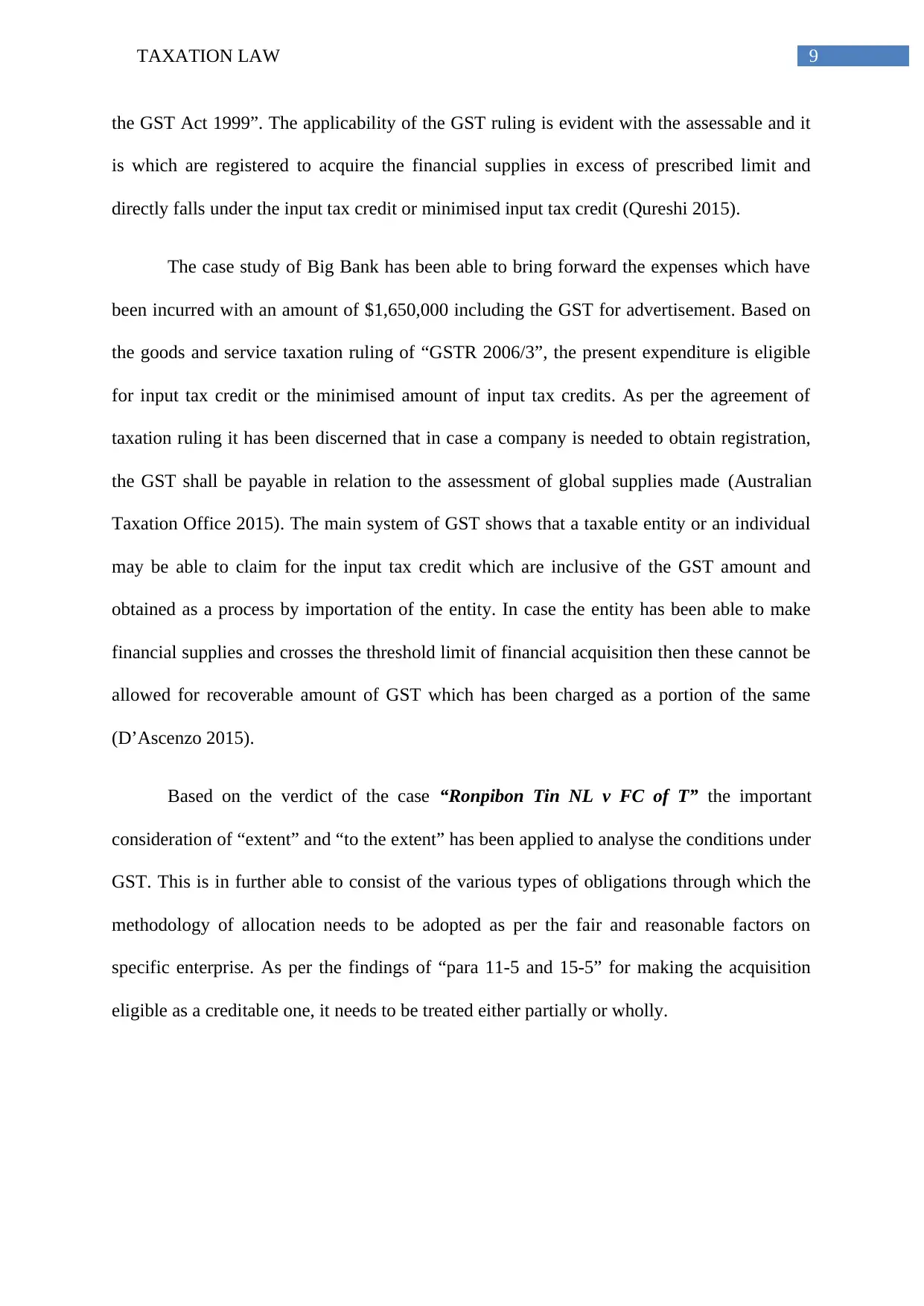
9TAXATION LAW
the GST Act 1999”. The applicability of the GST ruling is evident with the assessable and it
is which are registered to acquire the financial supplies in excess of prescribed limit and
directly falls under the input tax credit or minimised input tax credit (Qureshi 2015).
The case study of Big Bank has been able to bring forward the expenses which have
been incurred with an amount of $1,650,000 including the GST for advertisement. Based on
the goods and service taxation ruling of “GSTR 2006/3”, the present expenditure is eligible
for input tax credit or the minimised amount of input tax credits. As per the agreement of
taxation ruling it has been discerned that in case a company is needed to obtain registration,
the GST shall be payable in relation to the assessment of global supplies made (Australian
Taxation Office 2015). The main system of GST shows that a taxable entity or an individual
may be able to claim for the input tax credit which are inclusive of the GST amount and
obtained as a process by importation of the entity. In case the entity has been able to make
financial supplies and crosses the threshold limit of financial acquisition then these cannot be
allowed for recoverable amount of GST which has been charged as a portion of the same
(D’Ascenzo 2015).
Based on the verdict of the case “Ronpibon Tin NL v FC of T” the important
consideration of “extent” and “to the extent” has been applied to analyse the conditions under
GST. This is in further able to consist of the various types of obligations through which the
methodology of allocation needs to be adopted as per the fair and reasonable factors on
specific enterprise. As per the findings of “para 11-5 and 15-5” for making the acquisition
eligible as a creditable one, it needs to be treated either partially or wholly.
the GST Act 1999”. The applicability of the GST ruling is evident with the assessable and it
is which are registered to acquire the financial supplies in excess of prescribed limit and
directly falls under the input tax credit or minimised input tax credit (Qureshi 2015).
The case study of Big Bank has been able to bring forward the expenses which have
been incurred with an amount of $1,650,000 including the GST for advertisement. Based on
the goods and service taxation ruling of “GSTR 2006/3”, the present expenditure is eligible
for input tax credit or the minimised amount of input tax credits. As per the agreement of
taxation ruling it has been discerned that in case a company is needed to obtain registration,
the GST shall be payable in relation to the assessment of global supplies made (Australian
Taxation Office 2015). The main system of GST shows that a taxable entity or an individual
may be able to claim for the input tax credit which are inclusive of the GST amount and
obtained as a process by importation of the entity. In case the entity has been able to make
financial supplies and crosses the threshold limit of financial acquisition then these cannot be
allowed for recoverable amount of GST which has been charged as a portion of the same
(D’Ascenzo 2015).
Based on the verdict of the case “Ronpibon Tin NL v FC of T” the important
consideration of “extent” and “to the extent” has been applied to analyse the conditions under
GST. This is in further able to consist of the various types of obligations through which the
methodology of allocation needs to be adopted as per the fair and reasonable factors on
specific enterprise. As per the findings of “para 11-5 and 15-5” for making the acquisition
eligible as a creditable one, it needs to be treated either partially or wholly.
Paraphrase This Document
Need a fresh take? Get an instant paraphrase of this document with our AI Paraphraser
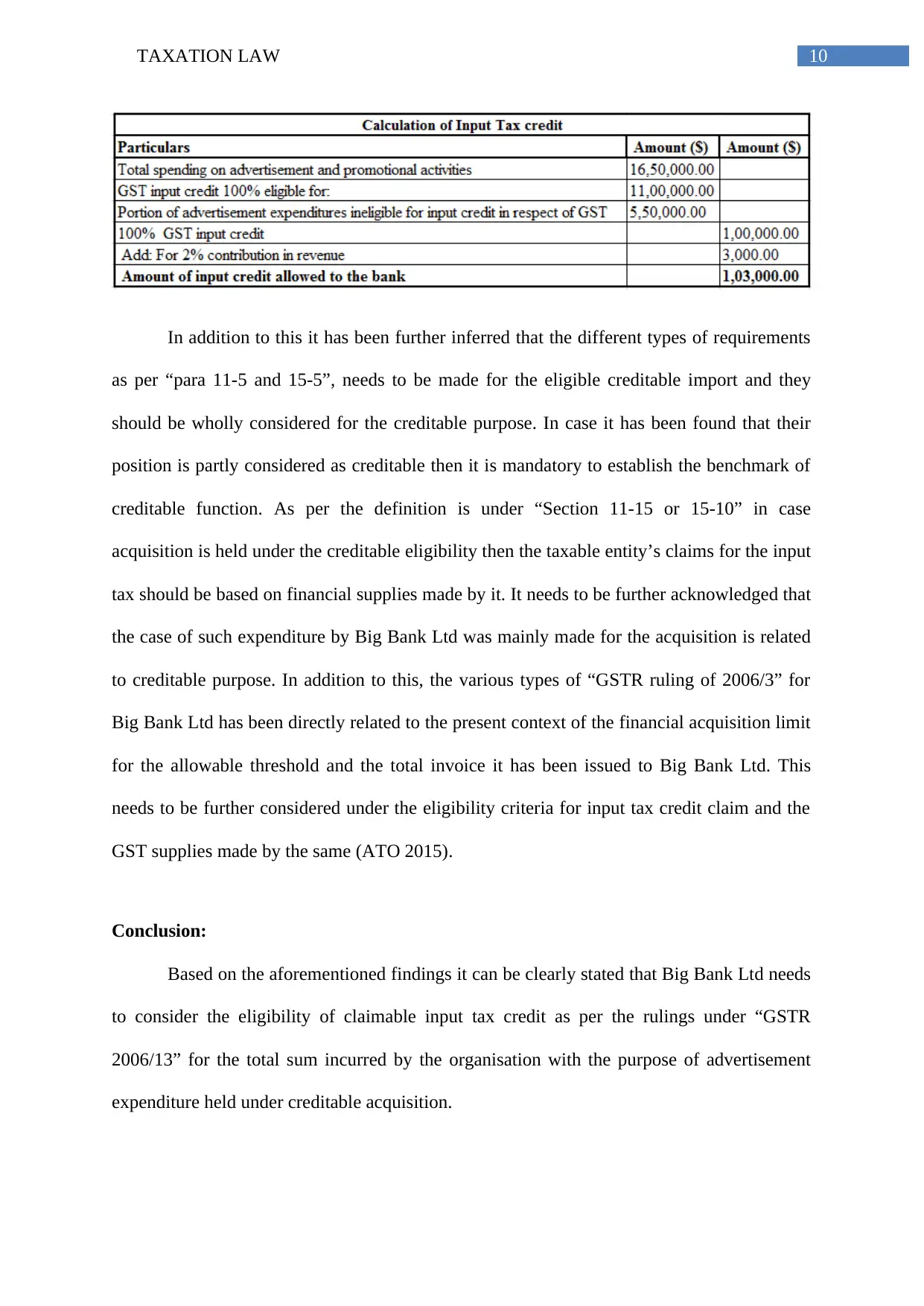
10TAXATION LAW
In addition to this it has been further inferred that the different types of requirements
as per “para 11-5 and 15-5”, needs to be made for the eligible creditable import and they
should be wholly considered for the creditable purpose. In case it has been found that their
position is partly considered as creditable then it is mandatory to establish the benchmark of
creditable function. As per the definition is under “Section 11-15 or 15-10” in case
acquisition is held under the creditable eligibility then the taxable entity’s claims for the input
tax should be based on financial supplies made by it. It needs to be further acknowledged that
the case of such expenditure by Big Bank Ltd was mainly made for the acquisition is related
to creditable purpose. In addition to this, the various types of “GSTR ruling of 2006/3” for
Big Bank Ltd has been directly related to the present context of the financial acquisition limit
for the allowable threshold and the total invoice it has been issued to Big Bank Ltd. This
needs to be further considered under the eligibility criteria for input tax credit claim and the
GST supplies made by the same (ATO 2015).
Conclusion:
Based on the aforementioned findings it can be clearly stated that Big Bank Ltd needs
to consider the eligibility of claimable input tax credit as per the rulings under “GSTR
2006/13” for the total sum incurred by the organisation with the purpose of advertisement
expenditure held under creditable acquisition.
In addition to this it has been further inferred that the different types of requirements
as per “para 11-5 and 15-5”, needs to be made for the eligible creditable import and they
should be wholly considered for the creditable purpose. In case it has been found that their
position is partly considered as creditable then it is mandatory to establish the benchmark of
creditable function. As per the definition is under “Section 11-15 or 15-10” in case
acquisition is held under the creditable eligibility then the taxable entity’s claims for the input
tax should be based on financial supplies made by it. It needs to be further acknowledged that
the case of such expenditure by Big Bank Ltd was mainly made for the acquisition is related
to creditable purpose. In addition to this, the various types of “GSTR ruling of 2006/3” for
Big Bank Ltd has been directly related to the present context of the financial acquisition limit
for the allowable threshold and the total invoice it has been issued to Big Bank Ltd. This
needs to be further considered under the eligibility criteria for input tax credit claim and the
GST supplies made by the same (ATO 2015).
Conclusion:
Based on the aforementioned findings it can be clearly stated that Big Bank Ltd needs
to consider the eligibility of claimable input tax credit as per the rulings under “GSTR
2006/13” for the total sum incurred by the organisation with the purpose of advertisement
expenditure held under creditable acquisition.
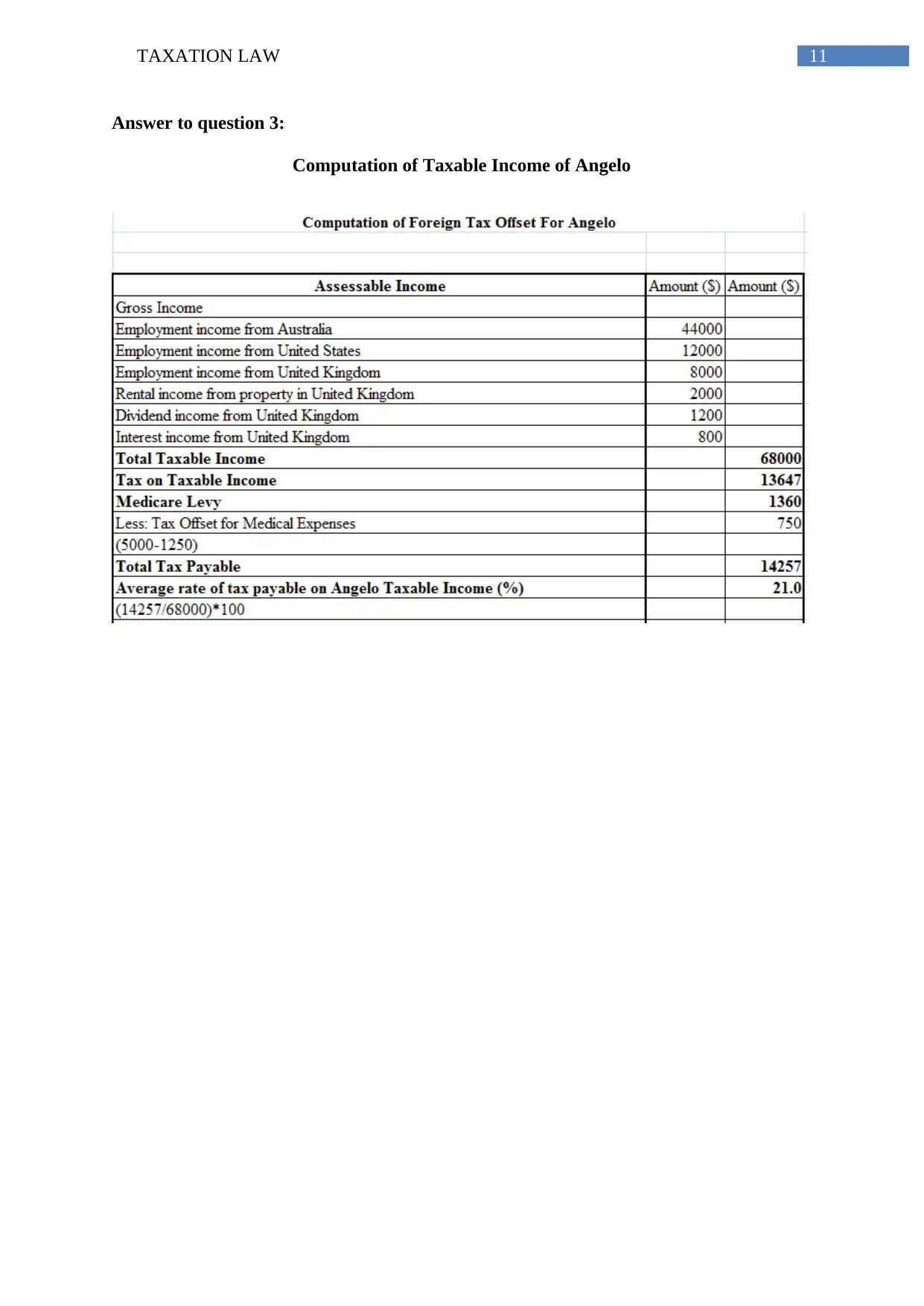
11TAXATION LAW
Answer to question 3:
Computation of Taxable Income of Angelo
Answer to question 3:
Computation of Taxable Income of Angelo
⊘ This is a preview!⊘
Do you want full access?
Subscribe today to unlock all pages.

Trusted by 1+ million students worldwide
1 out of 17
Related Documents
Your All-in-One AI-Powered Toolkit for Academic Success.
+13062052269
info@desklib.com
Available 24*7 on WhatsApp / Email
![[object Object]](/_next/static/media/star-bottom.7253800d.svg)
Unlock your academic potential
Copyright © 2020–2025 A2Z Services. All Rights Reserved. Developed and managed by ZUCOL.





